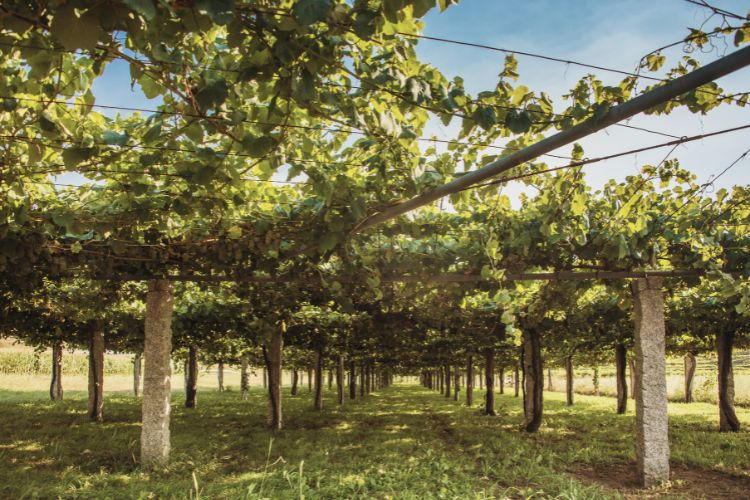Learn About the Albariño Grape Variety and Albariño Wine Styles
Last Updated on January 21, 2024.
Albariño, known as Alvarinho in Portugal, is a Galician variety currently found in coastal regions of the Iberian peninsula. At one point thought to be a relative of Riesling, it is now thought to be a cousin of Petit Manseng, a French grape typically used in blends in southern France.
IN THIS GUIDE:
- Taste
- Pairings
- Terroir
- Aging
- Wine Recommendations
- …and more
Albariño is a summertime favorite in Spain and Portugal, and that popularity has finally crossed the Atlantic. Some California producers are now growing Albariño as well, as are some in Oregon and Washington.
What Does Albariño Taste Like?
Albariño closely resembles the flavor of some Sauvignon Blanc wines, however, it is not as herbal or vegetable-forward as a typical Sauvignon Blanc. Albariños tend to be bone dry and are usually very acidic. Classic fruit notes include grapefruit and tangerine, as well as citrus fruit like lime and lemon – though more towards the bright side and not the astringent side. Albariño also typically has stone fruit notes of peach and nectarine. Secondary notes tend to include asparagus, eucalyptus, black olive, smoke, walnut, grass and salty minerality.
RELATED: Learn About and Visit the Rías Baixas Region to Try Albariño
Climate and Terroir for Albariño

The grape grows in the region of Galicia, which is located in the northwestern part of Spain. The specific area in Galicia that grows Albariño is dubbed Rías Baixas. It’s an area that is mostly surrounded by the Atlantic Ocean, which contributes to its maritime climate — allowing for cool nights to help lock in that high acidity.
Some say it is no coincidence Albariño grows so well here, since the grape originated in northeastern Portugal, where it’s known as Alvarinho. If ever it was said that the food and wine of a land were interconnected, you would be hard-pressed to find better examples than within Galicia, with its lively bright white wines and love for seafood.
Exploring Albariño Beyond Spain and Portugal
Albariño’s Global Journey and Varied Expressions
Albariño wines have now ventured far beyond its traditional borders. New Zealand, with its maritime climate, has been experimenting with this white grape variety, adding a unique twist to the classic profile. Here, Albariño wines often express a symphony of tropical fruit notes, mingling with the traditional citrus aromas. Enthusiasts can recognize a delightful presence of lemon zest and white flowers, adding a new dimension to the Albariño’s taste buds awakening profile.
RELATED: South Island New Zealand: Itinerary for Winetravelers
The American Albariño Evolution
In the United States, particularly in regions like San Luis Obispo and the broader Californian coast, Albariño vines are thriving in the granite soils and coastal climate. These New World adaptations of the Albariño grape have led to a fascinating blend of the traditional and the novel. The resulting Albarino wine, often aged in oak barrels, reveals a complexity where the crisp acidity and citrus flavors of the old mingle with the warm, oak-aged notes of the new. This fusion creates medium-bodied wines that retain the light body and mouth-watering acidity of the classic Albariño while introducing new tasting notes like green apple and orange zest.
Albariño has recently found a home in Uruguay as well, thriving in the rugged terrain.

Albariño Food Pairings
Albariño pairs beautifully with seafood, the fresher the better! Simple grilled shrimp, Spanish-style clams with garlic, mussels, crab, scallops – it all works. Albariño also works well with grilled vegetables, like asparagus, and most lighter summer fare, like fresh salads. For cheese pairings, go with lighter, fresher cheeses – mild goat cheese or fresh burrata work well.
While Albariño’s compatibility with food is legendary, especially with local seafood dishes from its home region, this dry white wine has found new partners. In warmer climates, where the wine develops a richer profile, it becomes a great match for white meats and lighter meats like poultry. The blend of citrus aromas and flavors in these wines, coupled with their light body and crisp acidity, makes them a perfect match for dishes like fish tacos or seafood paella. On a hot day, sipping a chilled Albariño in a white wine glass alongside these dishes can be a refreshing experience.
How is Albariño Aged?
The traditional view of Albariño is that it’s best enjoyed young, but there’s a growing recognition of its aging potential, particularly when aged on lees. This process involves allowing the wine to remain in contact with the dead yeast cells and other particulates after fermentation, which can enhance the wine’s complexity and body.
One notable example of Albariño that undergoes lees aging is Granbazán’s “Etiqueta Ámbar” from the Val do Salnés region in Rías Baixas, Spain. This wine is aged on the lees for about five months, which contributes to its rich texture and nuanced flavors of white peach, mandarin orange, and honeydew melon, along with a mineral-driven finish.
Interestingly, the aging potential of Albariño is being increasingly explored. Wines like Granbazán’s “Etiqueta Ámbar” and Pazo de Señorans from Rías Baixas are demonstrating that with careful vineyard management and winemaking techniques, Albariño can evolve over several years, offering new dimensions of flavor and complexity. The high natural acidity of the grape is a key factor in its aging potential, especially in the cool and humid climate of Galicia, where the grapes ripen slowly and develop deep flavors. Some winemakers opt for oxidative winemaking styles, using old oak for vinification and aging, while others prefer stainless-steel vats. Regardless of the method, the importance of lees is widely recognized for contributing to the wine’s body and flavor profile.
The Albariño de Fefiñanes III Año from Bodegas del Palacio de Fefiñanes is another example that showcases the aging potential of Albariño. This wine undergoes an extended aging process on lees after primary fermentation in stainless steel vats, leading to a magnificent expression of the grape’s capabilities.
The unique climate and granite soils of Rías Baixas play a crucial role in the ageability of Albariño wines. The high humidity and mineral-rich soils contribute to the wine’s structure and depth, providing a solid foundation for aging. This interaction creates an ideal environment for producing Albariño wines that can improve and evolve over time, showcasing vibrant fruit flavors and a solid aging potential.
As a result, while most consumers are familiar with the younger, fresher style of Albariño, there’s a growing interest in exploring the aged versions of this versatile grape. The market reception to aged Albariño wines has been mixed but encouraging, and this niche market is gradually gaining traction among wine enthusiasts and collectors.
Try any of these beautiful Albariño wine recommendations from around the world:


Two of our favorite brands producing Albariño out of Rias Baixas are Terras Gauda and Santiago Ruiz. You can buy bottles of the exceptional Terras Gauda Albariño blend here, as well as the Santiago Ruiz on Wine.com, delivered to your door.
More Great Albarino Wines to Purchase
- La Caña Navia, Rías Baixas, Spain
- Pazo de Señorans, Rías Baixas, Spain
- João Portugal Ramos, Vinho Verde, Portugal
- Hendry, Napa Valley, California
- Joyce Vineyards, Arroyo Seco, Monterey, Central Coast, California
- Bodegas Garzón, Uruguay
Celebrating Albariño – A Day for Wine Lovers
Recognizing the growing popularity of this delightful white wine grape, ‘Albariño Day‘ has emerged as a celebration for wine lovers worldwide. It’s a day to explore different varieties from the classic region of Rias Baixas to the newer vineyards in the Adelaide Hills or the United States. Winetravelers are encouraged to explore beyond their usual choices, perhaps trying an Albariño aged in stainless steel tanks for a purer fruit expression or one matured in contact with dead yeast cells for added complexity. Whether it’s your first time or you’re a seasoned connoisseur, Albariño Day is an invitation to explore the diverse world of this bright, zesty wine.
Learn About These Other Wine Grape Varieties
- Chenin Blanc
- Cabernet Sauvignon
- Grenache
- Malbec
- Marsanne
- Nebbiolo
- Petit Verdot
- Pinot Grigio
- Pinot Meunier
- Riesling
- Tannat
- Teroldego
Written By Jamie Metzgar
Jamie Elizabeth Metzgar began her career in wine by pouring in a tasting room on the East End of Long Island, NY. After moving to New York City, she landed a position at Chambers Street Wines where she was encouraged to pursue wine education at the Wine & Spirits Education Trust (WSET). She earned Level III certification there and has since earned California Wine Appellation Specialist and Certified Specialist of Wine certifications as well. After way too many moves, she has recently landed in Northern California where she is compiling an unofficial roster of dog-friendly tasting rooms.
Fruit
Citrus Fruits (Grapefruit and Lemons)
Stone Fruits (Peaches and Nectarines)
Earth & Mineral Notes
Vegetable, Asparagus, Eucalyptus, Black Olive
Additional Complexities
Smoke, Walnut, Grass
Structure & Body
Albarino Wine Profile
Body Medium
Sugar Dry
Tannins Light
Acidity High
Alcohol Medium